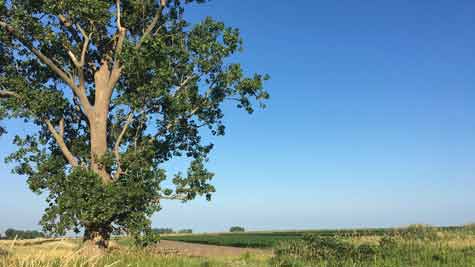There is no silver bullet to fight climate change or keep waterways clean, but protecting forests is one of the best things we can do in Michigan. Trees and forests manage stormwater. They filter pollution from the water and air, and they sequester heat-trapping carbon from the atmosphere.
Trees Fight Climate Change
Climate change will amplify many of the threats to people and wildlife in our watershed. We will experience more dangerous heat waves and stronger, more frequent storms as the world warms. Forests will help manage the unavoidable effects of a warming world and work to avoid the unmanageable.
Trees sequester, or lock away, large amounts of heat-trapping carbon dioxide from the atmosphere. On a global scale, this is critical for slowing the rate of climate change. In the U.S. forests offset about 10-20% of our carbon emissions from the burning of fossil fuels each year.
Trees get better and better at storing carbon as they grow until hitting a plateau just before they die. A mature maple tree, for example, stores about 500 pounds of carbon dioxide per year. The Huron River watershed is home to large areas of wetland and hardwood forests, which are a relatively good forest type for storing carbon. Each acre of 50-year old hardwood forest sequesters about 30,000 pounds of carbon dioxide per year. That’s enough to offset the carbon emissions from 1.6 average U.S. homes, making mature, hardwood forests especially important to protect. Wetland forests and wetlands are even better.
Trees and forests also help us adapt to the unavoidable effects of climate change. They release oxygen to the atmosphere through photosynthesis. They remove pollutants that conspire with high temperatures to create smog. As we continue to see more dangerous heat waves, trees provide shade and cool relief. And as storms grow stronger and more frequent, trees break the wind, soak up tremendous amounts of stormwater, and reduce erosion.
Trees Protect Water
Forests slow the flow of water by intercepting precipitation and by consuming water in the ground. That reduction in flow to our waterways filters pollution, reduces flood risk, and protects nearby land and homes from damage.
Trees and forests need tremendous amounts of water. A mature oak tree, for example, can consume over 40,000 gallons of water in a year. In healthy forests of the Huron River watershed, about 24 of our 36 inches of annual rainfall is taken up by trees and is evaporated back into the environment. This process also helps moderate nearby hot summer temperatures.
Tree canopies intercept snow and rainfall, absorbing some of the water and slowing the rest as it makes its way to the ground. The average interception of rainfall by a forest canopy ranges from 10-40% depending on species, time of year, and precipitation rates per storm event. A single deciduous tree can intercept from 500 to 760 gallons per year. A mature evergreen can intercept more than 4,000 gallons per year. Experts estimate that planting large canopy trees over impervious surfaces in urban settings (like parking lots or streets) has up to 8 times the benefit, because they directly reduce abrupt runoff from high-volume rain events that bring the most pollution to waterways.
The forest floor acts like an enormous sponge. Depending on soil composition and what’s beneath the surface, a forest can typically absorb up to 18 inches of precipitation and gradually release it to flow over the surface or to recharge groundwater. With the exception of wetlands, forests’ ability to absorb water is unmatched by most landscape types. Compared to suburban turf or agricultural areas, forests absorb 2 to 4 times the amount of water per hour.
More Tree Benefits
Forests are clearly amazing, valuable ecosystems, but their value goes way beyond fighting climate change and keeping water clean. They provide habitat and food for wildlife. They improve air quality by filtering pollutants. Neighborhoods with more trees experience less crime. They increase the value of nearby homes. They make neighborhoods more pleasant, and people go to great lengths to keep living and working near beautiful forests. Over time, that helps build strengthen community social connections as people continue to live near each other for longer.
What You Can Do
In the Huron River watershed, we can all help protect forests by advocating for smart development ordinances in our townships or cities that protect existing natural areas and leave mature forests standing.
At home, we can plant trees, especially in areas of open lawn.
Check out HRWC’s tree-resilience toolkit to pick which trees will be suitable for our future climate. Check with your community for any restrictions on tree species if the tree will be planted in the lawn extension.
Get tips to purchase healthy trees and shrubs, plant them properly, and manage them successfully.
Calculate the benefits of your existing trees, including carbon dioxide sequestered and stormwater runoff avoided.



